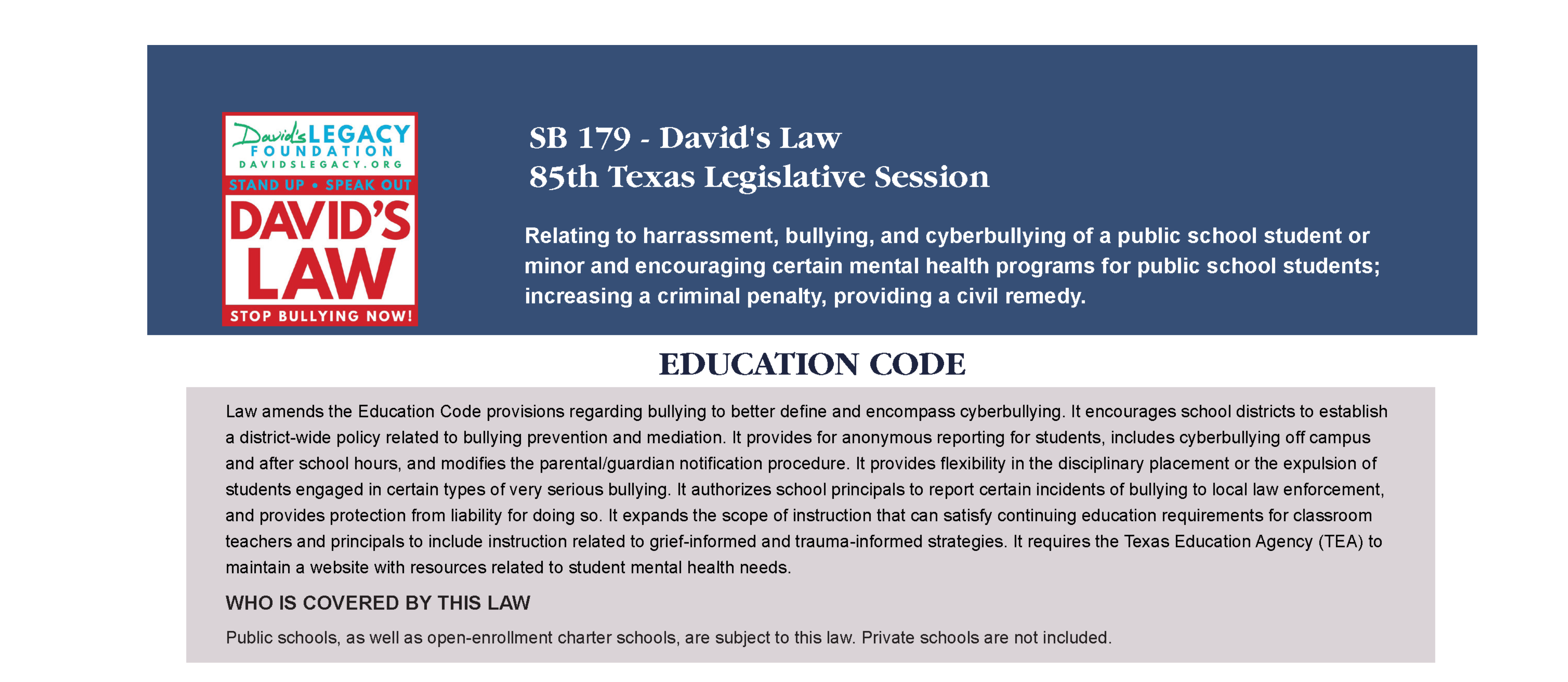
Call our Hotline @ 956-262-0543
Defining Bullying
"Cyberbullying" as defined in David’s Law means bullying arising from a pattern of acts or one significant act that is done through the use of any electronic communication device, including a cellular or other type of telephone, a computer, a camera, electronic mail, instant messaging, text messaging, a social media application, an Internet website, or any other Internet-based communication tool. WHERE THIS LAW APPLIES Because of David's Law, “cyberbullying” is now more specifically included in the definition of "bullying" in the Education Code. The bullying provisions in the Education Code (including pre-existing law and changes made by David’s Law) apply to: • Bullying that occurs on or is delivered to a school property or to the site of a school-sponsored or school-related activity on or off school property; • Bullying that occurs on a publicly or privately owned school bus or vehicle being used for transportation of students to or from school or a school-sponsored or school-related activity; • Cyberbullying that occurs off school property or outside of a school-sponsored or school-related activity if the cyberbullying interferes with a student 's educational opportunities or substantially disrupts the orderly operation of a classroom, school, or school-sponsored or school-related activity. (This expansion of a school district’s authority to include off-campus incidents is one of the most significant aspects of David’s Law.)
Notice of Bullying
David's Law requires the board of trustees of each school district to have the notice procedures under its bullying policy provide for notice of an incident of bullying: • To a parent or guardian of the alleged victim on or before the third business day after the date the incident is reported (the specification of three business days being new); and • A parent or guardian of the alleged bully within a reasonable amount of time after the incident (as under pre-existing law). WHO CAN REPORT David's Law makes it possible for students to anonymously report an incident of any type of bullying, including cyberbullying. (Parents and teachers can still report bullying, but a procedure for anonymous reporting is only required for reporting by students.) The principal or a person designated by the principal (other than a school counselor) is authorized under David’s Law to make a report of certain bullying that rises to the level of being a crime to any school district police department or the police department of the municipality in which the school is located. If the school is not in a municipality, the person reporting the bullying can contact the sheriff of the county in which the school is located. Additionally, a person who is not a school employee but is employed by an entity that contracts with a district or school to use school property is not required to make a report and may not be designated by the principal to make a report. Furthermore, strong protections from civil or criminal liabilities, and from disciplinary action, are given to schools and school personnel who report criminal bullying to law enforcement officials under this law.
Engaging in Certain Bullying
This law authorizes a school to remove a student who is engaging in bullying activity from class and place them in a disciplinary alternative education program or expel them if they encourage a student to die by suicide, attempt suicide, incite violence against a student through group bullying; or release or threaten to release intimate visual material of a minor or of a student who is 18 years of age or older without the student 's consent.
Counselor's Role
David’s Law provides that in addition to a school counselor’s responsibilities, the counselor will serve as an impartial, non-reporting resource for interpersonal conflicts and discord involving two or more students, including accusations of bullying. This role will not exempt a school counselor from any mandatory reporting requirements imposed by other provisions of law.
Prevention
The new law adds the following to the areas that are to be covered by the list prepared and maintained by the Department of State Health Services of recommended best practice-based programs for implementation in public schools (from which school districts may select for implementation in the district): • Early mental health intervention; • Mental health promotion; • Substance abuse prevention; • Substance abuse intervention; • Suicide prevention; • Grief-informed and trauma-informed practices; • Skills related to managing emotions, establishing and maintaining positive relationships, and responsible decision-making; • Positive behavior interventions and supports and positive youth development; and • Safe and supportive school climate.
Resources
The Texas Education Agency, in coordination with the Health and Human Services Commission, will create and maintain a website to provide resources for school employees regarding working with students with mental health conditions. The website information must include: • Grief-informed and trauma-informed practices; • Building skills related to managing emotions, establishing and maintaining positive relationships, and responsible decision-making; • Positive behavior interventions and support; and • A safe and supportive school climate.
Website: davidslegacy.org Email: info@davidslegacy.org Mailing Address: P.O. Box 90732 San Antonio, Texas 78209
Civil Relief of Cyberbullying of a Minor
David’s Law creates a new avenue of civil relief for cyberbullying victims who are minors by allowing a cyberbullying victim younger than 18 years of age at the time the cyberbullying occurs (or a parent of or person standing in parental relation to that victim) to seek injunctive relief, such as a temporary restraining order and/or an injunction, against the cyberbully, with some of the requirements normally applicable to injunctive relief being significantly relaxed. Also, these victims will be able to have the court issue an injunction against not only the cyberbully, but also against the cyberbully’s parents, requiring those parents to take action to stop their child from cyberbullying. This law requires the Texas Supreme Court to make available to the general public easy-to-understand forms and instructions (both in English and in Spanish) that can be used to apply for initial injunctive relief in suits involving cyberbullying under David’s Law
Criminal Harrasment Statue
David’s Law changes Section 42.07 of the Penal Code, better known as the Harassment Statute, to more fully and clearly include the modern Internet-based communication tools and methods perpetrators use to cyberbully their victims. Also, under the changes made by David’s Law, if a person commits an offense under the cyberbullying provision of the Harassment Statute, it is a Class A misdemeanor (rather than merely a Class B misdemeanor) if: • The person has previously been convicted under this section; or • The offense was committed against a child under 18 years of age with the intent that the child die by suicide or engage in conduct causing serious bodily injury to the child; or • The person has previously violated a temporary restraining order or injunction issued under the new civil provisions in David’s Law (discussed above).
